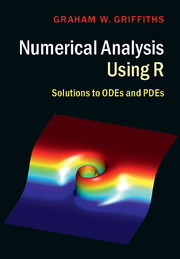Book contents
- Frontmatter
- Dedication
- Contents
- Preface
- 1 ODE Integration Methods
- 2 Stability Analysis of ODE Integrators
- 3 Numerical Solution of PDEs
- 4 PDE Stability Analysis
- 5 Dissipation and Dispersion
- 6 High-Resolution Schemes
- 7 Meshless Methods
- 8 Conservation Laws
- 9 Case Study: Analysis of Golf Ball Flight
- 10 Case Study: Taylor–Sedov Blast Wave
- 11 CaseStudy: The Carbon Cycle
- Appendix: A Mathematical Aide-Mémoire
- Index
- Plate section
- References
5 - Dissipation and Dispersion
Published online by Cambridge University Press: 05 May 2016
- Frontmatter
- Dedication
- Contents
- Preface
- 1 ODE Integration Methods
- 2 Stability Analysis of ODE Integrators
- 3 Numerical Solution of PDEs
- 4 PDE Stability Analysis
- 5 Dissipation and Dispersion
- 6 High-Resolution Schemes
- 7 Meshless Methods
- 8 Conservation Laws
- 9 Case Study: Analysis of Golf Ball Flight
- 10 Case Study: Taylor–Sedov Blast Wave
- 11 CaseStudy: The Carbon Cycle
- Appendix: A Mathematical Aide-Mémoire
- Index
- Plate section
- References
Summary
INTRODUCTION
The accuracy of a discretization scheme can be determined by comparing the numeric amplification factor Gnumeric with the exact amplification factor Gexact over one time step. Errors in magnitude are termed dissipation, and errors in phase are called dispersion. These terms are clarified subsequently. The term amplification factor is used to represent the change in magnitude of a solution over time. It can be calculated in either the time domain, by considering solution harmonics, or in the complex frequency domain, by taking Fourier transforms; we will work with solution harmonics. This analysis is intended to serve as an introduction to basic concepts and will therefore only consider systems described by linear PDEs with periodic boundary conditions and discretized over a uniform mesh.
For further reading, refer to [Hir-88, Chapter 8], [Lig-78, Chapter 3], [Tan-97, Chapter 4], and [Wes-01, Chapters 8 and 9].
DISPERSION RELATION
Physical waves that propagate in a particular medium will, in general, exhibit a specific group velocity as well as a specific phase velocity. This is because, within a particular medium, there is a fixed relationship between the wavenumber, ξ, and the frequency, ω, of waves. Thus, frequency and wavenumber are not independent quantities and are related by a functional relationship, known as the dispersion relation. The term frequency is used here to describe the rate of oscillation of a wave in time, whereas the term wave number is used to describe the rate of oscillation in space.
We will demonstrate the process of obtaining the dispersion relation by example, using the advection equation
ut + aux = 0.
Generally, each wavenumber, ξ, corresponds to s frequencies, where s is the order of the PDE with respect to t. Now any linear PDE with constant coefficients admits a solution of the form
u (x, t) = u0ei(ξx−ωt).
Because we are considering linear systems, the principle of superposition applies, and eqn. (5.2) can be considered to be a frequency component or harmonic of the Fourier series representation of a specific solution to the wave equation. On inserting this solution into a PDE we obtain the so-called dispersion relation between ω and ξ, that is,
ω = ω (ξ),
and each PDE will have its own distinct form.
Information
- Type
- Chapter
- Information
- Numerical Analysis Using RSolutions to ODEs and PDEs, pp. 264 - 284Publisher: Cambridge University PressPrint publication year: 2016
